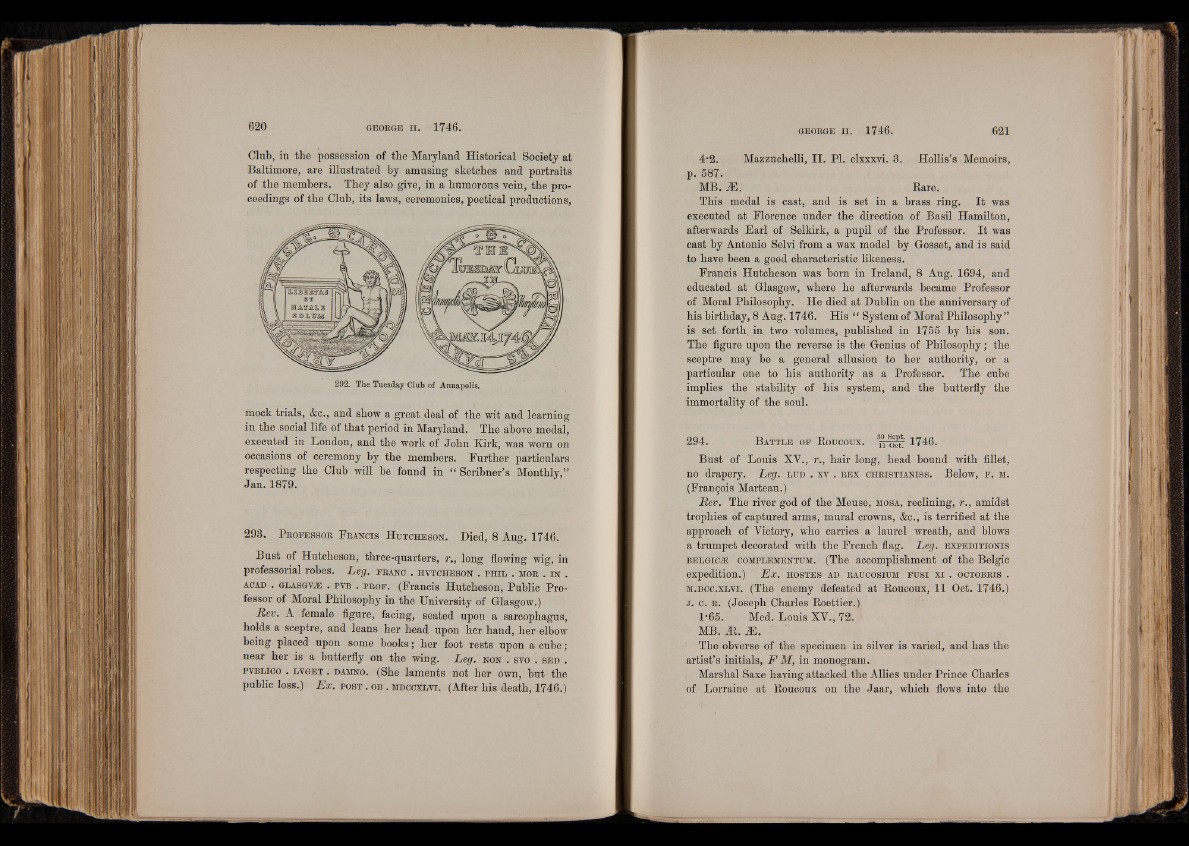
Club, in the possession of the Maryland Historical Society at
Baltimore, are illustrated by amusing sketches and portraits
of the members. They also give, in a humorous vein, the proceedings
of the Cluh, its laws, ceremonies, poetical productions,
292. The Tuesday Club of Annapolis.
mock trials, &c., and show a great deal of the wit and learning
in the social life of that period in Maryland. The above medal,
executed in London, and the work of John Kirk, was worn on
occasions of ceremony by the members. Further particulars
respecting the Club will be found in “ Scribner’s Monthly,”
Jan. 1879.
293. P e o f e s s o b F b a n c is H u t c h e s o n . D i e d , 8 A u g . 1746.
Bust of Hutcheson, three-quarters, r., long flowing wig, in
professorial robes. Leg. f e a n c . h v t c h e s o n . p h i l . m o b . in .
a c a d . g l a sg v a 3 . p v b . PEOP. (Francis Hutcheson, Public Professor
of Moral Philosophy in the University of Glasgow.)
Rev. A female figure, facing, seated upon a sarcophagus,
holds a sceptre, and leans her head upon her hand, her elbow
being placed upon some books; her foot rests upon a cube;
near her is a butterfly on the wing. Leg. n o n . svo . s e d .
p v b l ic o . l v g e t . d am n o . (She laments not her own, but the
public loss.) Ex. POST . OB . m d c c x l v i . (After his death, 1746.)
4-2. Mazzuchelli, II. PI. clxxxvi. 3. Hollis’s Memoirs,
p. 587.
MB. Æ. Rare.
This medal is cast, and is set in a brass ring. It was
executed at Florence under the direction of Basil Hamilton,
afterwards Earl of Selkirk, a pupil of the Professor. It was
cast by Antonio Selvi from a wax model by Gosset, and is said
to have been a good characteristic likeness.
Francis Hutcheson was born in Ireland, 8 Aug. 1694, and
educated at Glasgow, where he afterwards became Professor
of Moral Philosophy. He died at Dublin on the anniversary of
his birthday, 8 Aug. 1746. His “ System of Moral Philosophy”
is set forth, in two volumes, published in 1755 by his son.
The figure upon the reverse is the Genius of Philosophy ; the
sceptre may be a general allusion to her authority, or a
particular one to his authority as a Professor. The cube
implies the stability of his system, and the butterfly the
immortality of the soul.
294. B a t t l e o f Rouooux. 1746.
Bust of Louis XV., r., hair long, head hound with fillet,
no drapery. Leg. l u d . x v . e e x c h e i s t ia n i s s . Below, f . m .
(François Marteau.)
Rev. The river god of the Meuse, m o sa , reclining, r., amidst
trophies of captured arms, mural crowns, &c., is terrified at the
approach of Victory, who carries a laurel wreath, and blows
a trumpet decorated with the French flag. Leg. e x p e d i t i o n s
b e l g ic æ c o m p l e m e n t u m . (The accomplishment of the Belgic
expedition.) Ex. h o s t e s a d e a u c o s iu m f u s i x i . o c t o b b is .
m .d c c .x l v i . (The enemy defeated at Roucoux, 11 Oct. 1746.)
j . c . e . (Joseph Charles Roettier.)
1-65. Med. Louis XV., 72.
MB. Æ. Æ.
The obverse of the specimen in silver is varied, and has the
artist’s initials, F M, in monogram.
Marshal Saxe having attacked the Allies under Prince Charles
of Lorraine at Roucoux on the Jaar, which flows into the